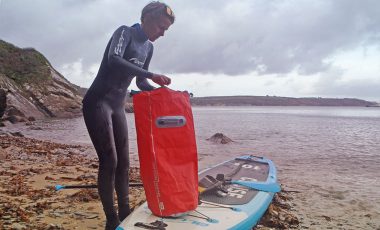Anyone who’s ever spent time on or near the water will know how miserable life can get without the right gear and clothing. Worse, actually. In reality, water-based and wet weather adventures with inadequate gear and clothing can be catastrophic, especially in more extreme or remote scenarios. Which is why investing in the best dry bags to suit the situation is essential. It’s not just you that really needs to stay dry when taking on the elements. Keeping spare clothing, gear and food dry is also extremely important, especially if you end up getting wet yourself!
I’ve been trying out an array of different types of dry bags over the last few months. They’ve come with me on rainy hiking and biking trips. Been filled with wetsuits and beach gear and dragged across the sand. They’ve kept me company on river day trips and paddle board camping trips on the river and the sea. And they’ve been subjected to full submersion in a rock pool at my local beach. All of the dry bags I’ve tested do what they’re supposed to, with some being better suited to more extreme exposure to the elements than others. Read on to find out more.
- The best dry bags for wet adventures
- Testing criteria
- Desirable properties of the best dry bags
- Features of the best dry bags
Summary of the best dry bags
Disclaimer: We use affiliate links and may receive a small commission on purchases.
| Product | Capacity | Type of dry bag | Best for | Cost |
|---|---|---|---|---|
| Sea to Summit Big River Bag | 13 litres | Tube | Watersports and boating | $ |
| Overboard Dry Tube | 40 litres | Tube | Watersports and boating | $ |
| Sea to Summit Ultra-Sil Dry Sack | 35 litres | Tube | Backpacking and watersports | $ |
| Exped Clear Sight 4 Pack | 3-13 litres | Tubes | Backpacking and watersports | $$ |
| Overboard Pro-Light Waist Pack | 2 litres | Hip pack | Cycling, hiking, watersports | $ |
| SealLine Seal Pak Hip Pack | 4 litres | Hip pack | Cycling, hiking, watersports | $$ |
| SealLine Boundary Dry Pack | 65 litres | Backpack | Watersports and beach time | $$$$$$ |
| Earth Pak Summit Dry Pack Backpack | 55 litres | Backpack | Watersports and beach time | $$$ |
| Aquapac Toccoa Backpack | 28 litres | Backpack | Hiking, cycling, watersports | $$$ |
| Overboard Classic Waterproof Backpack | 30 litres | Backpack | Hiking, cycling, watersports | $$$ |
The best dry bags for wet adventures
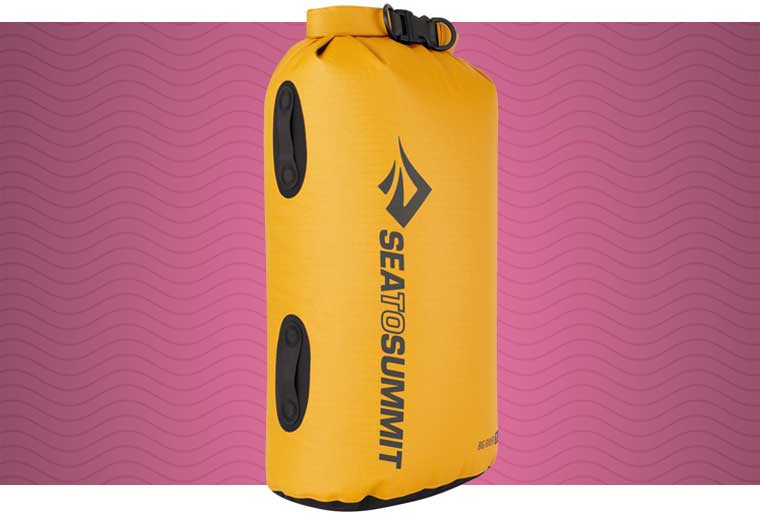

Sea to Summit Big River Bag
Waterproof rating: 10,000 HH
The Sea to Summit Big River Bag is one tough cookie of a dry bag. Boasting 420D TPU laminated fabric that is abrasion resistant, and with an HH of 10,000mm, it’s an ideal option for big river days, as the name suggests! Like the other Sea to Summit dry bag I tried out, the inside came out bone dry in the dunk-test. It has also dealt with full exposure in some rotten conditions strapped to the pannier rack on my bike. The side lash loops are perfect for securing it to my bike. Additionally, the benefits of the oval base, which help prevent it from rolling around in the bottom of a boat, are also greatly appreciated on a bike rack; it just sits much more nicely than a round-based bag.
Of all the options on our list, this is the best dry bag for kayaking day trips when you need maximum protection but don’t need / have the space to carry loads of gear. The 13 litre capacity is plenty to hold your lunch and some dry layers. The roll top opening also features a couple of D rings for securing to your boat or securing other stuff to it. And, like the Ultra-Sil Dry Sack, it comes with a spare buckle.
Pros
- Comes with spare buckle
- Versatile
- Has lash loops
- PVC-free
- No-roll oval base
Cons
- No haul handle
Find the latest price at:
Sea to Summit USA | Sea to Summit UK | REI
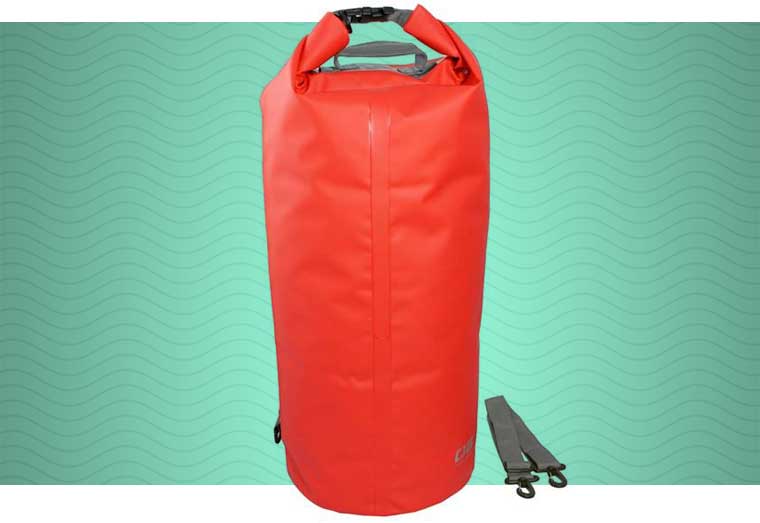

Overboard Dry Tube
Waterproof rating: IP66
For long days out on the water or overnight paddling trips, a large capacity dry bag, like this 40 litre Overboard Dry Tube, is invaluable. You can fit a load of gear in it, from dry layers and clothing to cookware and food, and it is one of the best dry bags for boating, rafting and paddle boarding on the list, in terms of usefulness.
This simple dry bag is constructed from mega tough 600D nylon-coated PVC tarpaulin that is complemented by welded seams for extra durability. It sure can take some hauling around! In terms of waterproofness, it is IP66 rated, which means that it floats and can handle quick submersion. However, in the dunk test its contents came out dry indicating that the roll top seals very well when rolled tightly.
Two highly useful features of the Overboard Dry Tube are the top carry handle, for hauling the bag from place to place, and the shoulder strap. This is removable, should you wish. But it’s super useful when moving boats or vessels to and from the water as it leaves you hands-free.
Pros
- Super tough and durable
- Removable shoulder strap
- Haul handle
- Versatile
Cons
- No gear loops
Find the latest price at:
Drybags.co.uk


Sea to Summit Ultra-Sil Dry Sack
Waterproof rating: 2,000mm HH
Weighing in at a featherweight 65g / 2.3oz, yet with the ability to hold up to 35 litres of gear, the Sea to Summit Ultra-Sil Dry Sack is a miracle of science! Firstly, the 30D high tenacity Cordura nylon fabric, when compared with other types of dry bags, feels like it will tear if it just looks at a sharp rock, let alone keep out anything that resembles moisture. However, it’s as tough as the outer fly of a tent and endured a 2 minute dunking in a rock pool with its contents coming out bone dry. Incredible. The wonder fabric is also siliconised which adds an extra degree of durability and means that it slides in and out of your backpack with ease. So yes, it’s by far the best dry bag for backpacking and bike touring on our list. But its impressive waterproofness also makes it a great option for water-based trips where a little extra, lightweight storage is needed inside other dry bags.
The Ultra-Sil Dry Sack features a simple roll top opening with replaceable buckles, which I really like. Buckles are always the first thing to get busted on bags that get thrown around lots. The bag also dries very quickly and has reinforced stitched seams.
Pros
- Incredibly lightweight
- Comes with replaceable buckles
- Very strong, despite its weight
- PVC-free
Cons
- No carry handle
- No attachment loops
Find the latest price at:
Sea to Summit USA | Sea to Summit UK | REI
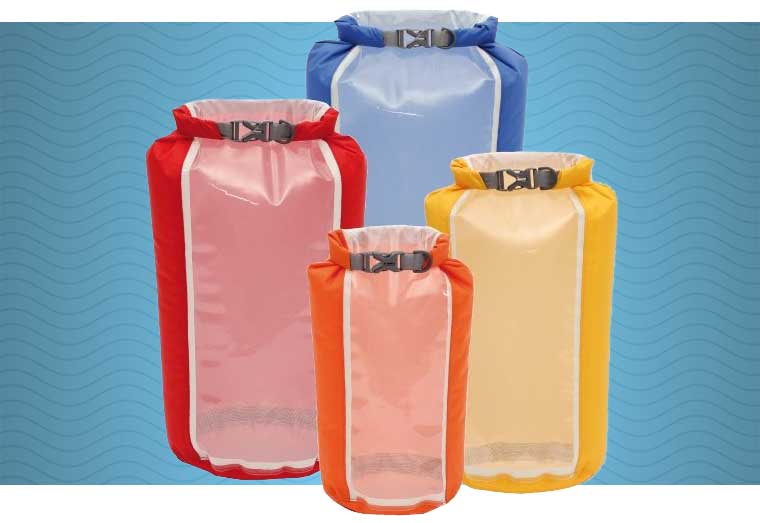

Exped Clear Sight 4 Pack
Waterproof rating: IP65 / 10,000mm HH
This 4 pack of 3-13 litres tubes is a must for anyone who likes their gear to stay well organised as well as dry. The combo of bags are dead useful in an unnamable number of scenarios. The small bags are great for storing my wet swimwear at the beach or for chucking in my phone and valuables on a wet hike inside a daypack. I also use them for storing my fire lighting kit in on overnight paddling trips or for keeping my loo roll dry when camping. The larger ones have even more uses, from storing my clothing and sleeping bag in to carrying all my food in on overnight hiking / paddling trips. They offer a really excellent way to keep your gear organised, either inside a larger dry bag on river trips, or in a backpack on hiking trips.
The bags didn’t do well in the dunk test. As air squeezed out of the bags at the roll top, water started to seep in. This result was to be expected as they’re only designed to be waterproof under short submersions (not a full-on two minute, underwater jostling!). Their waterproof rating is IP65 (foul weather proof). On their second test – left outside for a couple of days in intermittent rain and dew – their contents came out slightly damp, but not wet.
What makes this dry bag set stand out from other, similar dry bags that I’ve used in the past, is their clear windows. Though this adds an extra seam to the construction of the bags, it really helps with keeping track of your gear. The different colours also help with this. Another surprisingly essential feature of these simple dry bags is the handle on the base of each of them. This not only helps with hauling out the bags from the depths of your back, but it also helps when pulling out tightly stuffed gear, like clothing and sleeping bags, from inside the bags.
Pros
- Clear panels to see your gear
- Essential grab handle on the base
- Versatile
- Small D ring at the roll top for clipping onto stuff
- No-roll oval base makes for easy packing
- PVC-free
- Lightweight
Cons
- Not fully submersible
Find the latest price at:
Drybags.co.uk


Overboard Pro-Light Waist Pack
Waterproof rating: IP66
Though the Overboard Pro-Light Waist Pack only has a 2 litre capacity, it is actually a highly useful and versatile little dry pack in a variety of different scenarios. A few things I’ve used it for so far include: carrying my camera and a snack on rainy walks, storing essentials (sunglasses, suncream, camera) when paddle boarding, and carrying a repair kit, phone and snacks on bike rides. I’ve also tried it out with a phone and some gloves in on a short run, however it bounced around too much to be suitable for anything long distanced.
To further add to its usefulness, it features a zippered pocket to help organise your stuff, a foldaway water bottle holder (that’s great for walking if you don’t want to carry a daypack), and a fairly comfortable padded waist belt that is also adjustable to fit. Additionally, the roll top can be buckled either at the top or down at the sides to compress the pack down.
Its waterproofness doesn’t quite match that of the larger SealLine Hip Pack; it took on quite a bit of water in the dunk test so I always put my phone inside an additional waterproof case when paddle boarding. It also came out a little below par when left outside for a couple of days in intermittent rain and dew. Its contents came out slightly on the damp side, but not wet. That said, it is only designed to withstand a quick submersion (IP66). The tough TPU fabric with welded seams make this a highly durable pack and makes up for its shortcomings in the waterproof department. Overall, it’s one of the more versatile dry bags I’ve used, which I’ve been pleasantly surprised about.
Pros
- Highly versatile
- Welded seams
- PVC-free
- Comfortable
- Has fold out water bottle holder
Cons
- Not fully submersible
- Padded waist doesn’t dry super quickly
Find the latest price at:
Drybags.co.uk
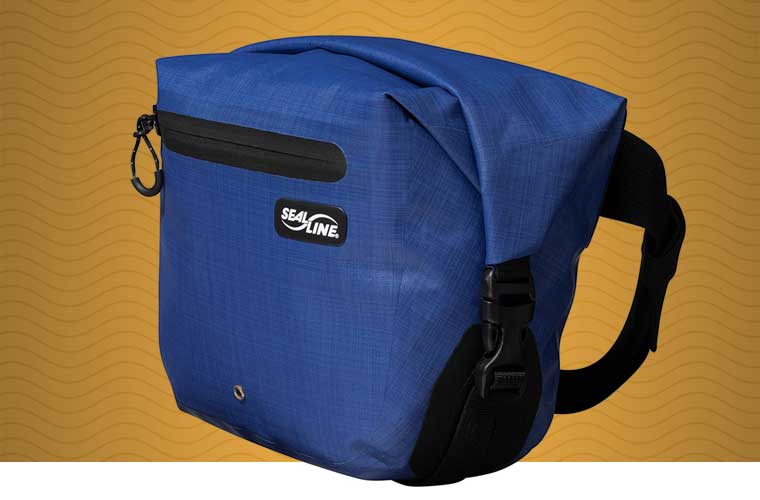

SealLine Seal Pak Hip Pack
Waterproof rating: Not rated, but equivalent of IP66
Like the Overboard Waist Pack, the SealLine Seal Pak Hip Pack is a highly versatile dry bag that’s ideal for short adventures in bad weather or on the water. Its larger capacity of 4 litres makes it more useful than the Overboard in certain scenarios when you need to carry a little extra gear (hiking and biking in changeable conditions or over longer distances etc).
This lightweight pack (179g / 6.3oz) is designed to withstands quick submersions and will float if dropped in the water. However, its contents, impressively, came out dry in the dunk test. It should be noted that the zippered pocket on the front is only splash proof and lets water in when submerged.
This is one of the more stylish dry bags I’ve tested making it a great option for traveling and everyday use in inclement conditions. Plus, it scores yet more brownie points on the tough cookie front, boasting welded seams and constructed from 250D polyurethane-coated polyester/nylon blend. It also adopts the same closing roll top as the Overboard Waist Pack, securing at top as well as the sides for extra compression.
Pros
- Versatile
- Lightweight
- Welded seams
- Stylish
- Adjustable and removable waist belt
- Side compression buckles
- PVC-free
- Water resistant zippered pocket
Cons
- No padding on the waist belt
Find the latest price at:
REI | SealLine Gear


SealLine Boundary Dry Pack
Waterproof rating: Not rated, but equivalent of IP66
The burly SealLine Boundary Dry Pack is the godfather of the dry bags world, and is not for the faint-hearted! Constructed from 1000D 18.5oz vinyl-coated polyester, and with an even beefier, reinforced base, this thing is built to endure and protect. It also has welded seams for further weatherproofing and durability. It came out of the dunk test without a droplet on the inside, though it is rated to only withstand quick submersions and will float if dropped in the water, like the SealLine Hip Pack.
With the capacity to carry up to 65 litres of gear, this is not a dry pack for everyday use, that’s for sure! But it’s one of the best dry packs for rafting, paddle boarding and boating trips when you need to haul a few days worth of gear. I’ve used it on overnight canoeing and paddle boarding trips (it carries everything you need for a few days on the water, and some). But it’s also a very good option for winter beach days when you need to carry multiple wetsuits for your party, as well as towels, wooly hats, layers and hot drinks.
It lacks pockets, from an organisational point of view. However, the highly comfortable and adjustable back panel and shoulder strap system means that carrying heavy loads is really doable over longer distances, if needed. You can also remove the backpack system entirely, which is a really nice feature if you need to streamline the bag when securing it to your vessel and don’t envisage having to carry it far.
Like the hip packs, the Aquapac Toccoa and the Earth Pak, the roll top secures closed both at the top and the sides and can be cinched right in for extra stability and compression. Additionally, there are two buckle straps that go over the top of the closure to further secure the bag closed.
Pros
- Huge capacity
- Bomb-proof (1000D polyester fabric)
- Welded seams
- Removable backpack harness
- Sternum strap
- Removable waist strap
Cons
- Not very versatile
- No pockets
Find the latest price at:
SealLine | Amazon
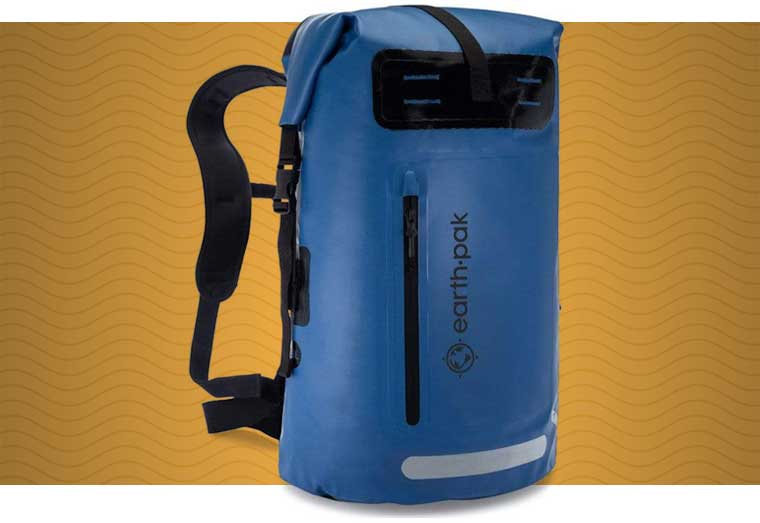

Earth Pak Summit Dry Pack Backpack
Waterproof rating: Not available
The 55 litre Earth Pak Summit Dry Pack Backpack is a slightly smaller, less gnarly version of the SealLine Boundary. Made from 500D PVC, it lacks the burly, robustness of the Boundary and as such, isn’t ideal for more extreme uses such as multi-day rafting. That said, the inside of the pack was completely dry after the dunk test. It has a much more basic shoulder strap system than the Boundary, which provides good levels of comfort for lighter loads (including a sternum strap and waist belt) but lacks the adjustability to deal with heavy weights.
Where the Earth Pak falls short in terms of durability and comfort, it comes out with flying colours when it comes to storage options. Firstly, the Earth Pak features two super useful internal pockets. One is zippered and the other is a mesh pouch. Both are designed to hold small items. There’s also a key clip next to the internal pockets. A really nice feature that none of the other dry bags I’ve used has.
Additionally, there’s an external zippered pocket that is splash-proof and ideal for storing things you need to access easily like suncream, sunglasses and a waterproof camera. There are also a couple of gear loops on the back of the pack, as well as a reflective strip for nighttime cycling missions.
Finally, the roll top closure can be secured either at the top or at the sides to compress the backpack. And, like the Boundary, there is a top compression strap to further cinch everything in.
Pros
- Really useful storage options
- Good value
- Versatile
- Bigger than it looks or feels
Cons
- Shoulder straps and back panel lack comfort
Find the latest price at:
Amazon | Earth Pak
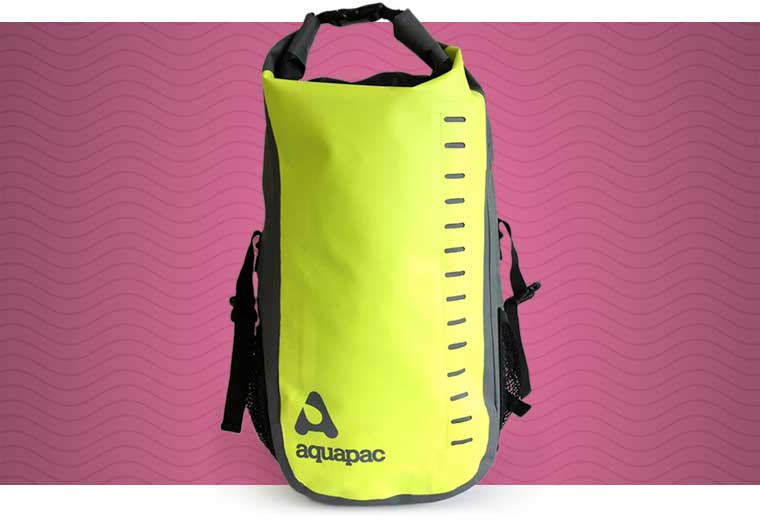

Aquapac Toccoa Backpack
Waterproof rating: IPX6
The Aquapac Toccoa Backpack is the smallest capacity (28 litres) dry bag backpack on this list and is very similar, in terms of usage, to the Overboard Classic Waterproof Backpack. It also compares closely in terms of construction (500D polyester-reinforced PVC tarpaulin with welded seams) and waterproofness (IPX6 Stormproof – protected against powerful water jets).
The Toccoa, also known as the Heavyweight Waterproof Daysack, is also best used for all the same things as the Overboard Classic: wet weather hiking and biking, as well beach time and paddling trips. Though the extra 2 litres offered by the Classic certainly has its advantages, the Toccoa comes out on top in terms of waterproofness (it came out favourably in the dunk test). Additionally, it offers better storage option. Firstly, the Toccoa has two mesh pockets and they both fit larger bottles in than the Classic. There are also more lash points for lights and daisy-chain webbing for securing extra gear.
That said, the shoulder straps and back panel don’t dry as quickly as the Classic or provide quite as much comfort.
Overall, the Toccoa is a great little pack that is ideal for everyday use in wet climates and a must for regular beach goers.
Pros
- Versatile
- Good for everyday use
- Durable and tough
- Two mesh side pockets
- Lots of gear loops
Cons
- No internal pockets
Find the latest price at:
Amazon | Aquapac


Overboard Classic Waterproof Backpack
Waterproof rating: IP66
Constructed from tough PVC and nylon with highly durable welded seams, this 30L waterproof backpack from Overboard certainly won’t let you down in terms of durability. It also has an IP rating of 66 which means that it floats and can handle quick submersion. In the dunk test, some water seeped into the roll top as air was squeezed out whilst it was being forced underwater. However, in normal scenarios (cycling and hiking in the rain and on SUP trips) it has kept my gear totally dry.
Boasting a padded back panel and shoulder straps, the Overboard Classic is surprisingly comfortable to wear on wet hikes and fits snugly when cycling. The adjustable sternum strap helps with this. It also features three D-rings on the back of the pack for fixing gear, a haul handle, two gear loops on the shoulder straps and a top waterproof seal strap that helps to seal the roll top down. The side mesh pocket is great for storing wet gear or a water bottle, though it could be bigger. Plus, there’s a velcro panel inside the main compartment to attach a backpack tidy to.
Overall this well designed and comfortable backpacking is an excellent option for anyone living an outdoor life in a rainy climate or for those who spend lots of time on or near the water. It’s great for hauling wetsuits to the beach, and out of all the backpacks I’ve tried, it’s the best dry bag backpack for cycling.
Pros
- Strong and durable
- Comfortable to carry
- Lots of gear loops
- Reflective strip for cycling
Cons
- No other pockets
- Not fully submersible
- No waist belt
Find the latest price at:
Drybags.co.uk
Testing criteria
All of these bags have been used in scenarios in which keeping your gear dry is essential. However, as you might be able to appreciate, there are times when dry gear is way more important than others. It’s not a disaster if spare layers get wet during a day hike in the rain, for example. However, a wet sleeping bag on an overnighter is a different story. As such, I’ll admit that some of the bags weren’t fully put to the test in situ. Nope, I didn’t submerge the bag with all my dry layers and sleeping stuff on an overnight paddle boarding trip! I just saved that for another time when I didn’t have to reap the consequences of a potential leak.
Submersion testing
To properly test the waterproofness of the bags, I filled them with newspaper and submerged them for two minutes in a rock pool at the beach. Some of the bags refused to be fully dunked. However, during the two minutes I jostled them under water at different angles ensuring that all the seams and seals saw their fair share of the bottom of the pool.
Of course, this is not a super realistic test. In the real world, gear from a capsized canoe or upturned SUP is (or at least should be) securely attached to the vessel and retrieved from the water as speedily as the vessel is righted. But that’s not always the case, and it’s nice to know that a dry bag will stand up to being held underwater.
A couple of the bags failed this ‘newspaper test’. Water came in through the roll-tops (which were all rolled at least three times) as the air squeezed out. It is worth noting, however, that all three of these bags have an IP rating of 66 (IP66). This means that they float and can handle quick submersion.
Practicality and usability test
As well as testing the waterproofness of the bags, I also tested their usability and suitability for the scenario. This was a much less structured test and consisted of the bags just being used as much as possible out on the river and sea, at the beach, and in the rain.
Desirable properties of the best dry bags
Waterproofness
It goes without saying that a dry bag should be waterproof. However, not all dry bags are made equal, with some being splash and rainproof rather than fully submersible in water. In general, dry bags made from thicker fabrics with welded seams tend to be better at keeping water out than thinner fabrics with sewn and taped seams. The anomaly is the Sea to Summit Ultra-Sil Dry Sack which is unfathomably lightweight and thin yet is fully waterproof when dunked in water for two minutes.
It’s worth noting that being fully submersible isn’t the be-all and end-all. Hiking in the rain doesn’t require a dry bag to be anywhere near as waterproof as a white water kayaking dry bag, for example. So there’s little point opting for the best dry bag in terms of waterproofness if you’re only going to be hiking with it. Save your pennies and opt for something that is best suited to your activity of choice.
Waterproof ratings
Unfortunately, different brands have different ways of rating an item’s waterproofness. So there’s no universal way to directly compare the bags on our list in this regard. However, the ratings provide a good understanding of the level of protection they provide against water.
Hydrostatic Head (HH) rating is the measure of how much water pressure fabric can deal with before water leaks through the fabric. The higher the number, the more waterproof the fabric.
Ingress Protection (IP) rating is often used to measure the waterproofness of electrical goods. But it can be applied to other items too. It usually comes with two numbers after it. Eg: IP56. The first number indicates how dustproof the item is (1-6) and the second number indicates how waterproof it is (1-9). The highest rating for the most water and dustproof items, is IP69.
Seams
To get an even better picture of how waterproof a dry bag is, you can also look at how the seams are constructed.
Welded seams are strong and very reliably waterproof. They are generally superior to sewn-and-taped seams. They use radio frequencies (RF) to join two pieces of coated fabric together at the molecular level, effectively bonding them together as one.
Sewn-and-taped seams aren’t as strong and reliable as welded seams. Two pieces of coated fabric are sewn together with thread. The thread and seams have a piece of protective tape placed over them to help seal out the water.
Though both types of seams keep water out, welded seams can deal with much more stress being put on them and therefore last much longer than stitch and taped seams
Durability
As mentioned above, the type of seam has a bearing on waterproofness. But it also influences the durability of dry bags. Welded seams are stronger than sewn-and-taped seams.
Aside from the seams, however, durability tends not to be too much of an issue with dry bags as they are inherently made from super tough, waterproof fabrics and are designed to be hauled, battered and dragged around!
The best dry bags are constructed from either PVC or a nylon-based fabric. Both these fabrics, and their variations, provide excellent durability. However, PVC, and its production, is more damaging to the environment. So if you’re looking for a more eco-friendly dry bag then the PVC-free options are a better bet.
PVC is tough, durable and abrasion resistant. It’s also cheap to produce.
Nylon is created in many different thicknesses and comes with a Denier (D) rating. The higher the rating the more durable the fabric is. Dry bags constructed from nylon tend to have a high D rating.
Weight
The weight of your dry bag of choice is only really significant if you are carrying it on your person. Backpacks and stuff sacks should ideally be on the lightweight side. Whereas dry bags used on boats, kayaks and SUPs can be a little heavier.
Features of the best dry bags
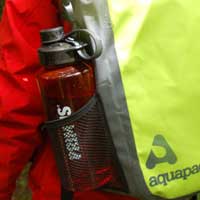
Mesh pockets
For storing wet gear, water bottles, and flip flops, mesh pockets are a common feature on waterproof backpacks.
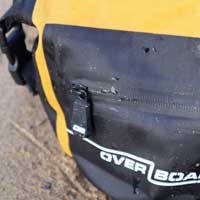
Zippered pockets
These are handy for accessing small items without opening the main compartment. Internal zippered pockets are also useful for organising your gear.

Roll-tops
Roll-tops offer greater water protection for your kit as well as versatility. Most roll-top dry bags are secured with buckles on either the side of the pack or together at the top which creates a large carry handle or extra attachment point.

Gear loops
External gear loops allow you to attached waterproof gear to the outside if your dry bag for easy access. They can also double as attachment points for securing the dry bag to your boat or SUP.
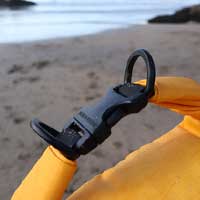
D-rings
Sturdy D-rings let you attach a carabiner clip or bungee cord and secure the dry bag to a paddle board, kayak, or canoe. Like gear loops, they’re also useful for clipping other gear onto your bag.

Shoulder Straps
Straps on waterproof backpacks should be made from quick-drying fabrics. Some have a webbed design which allows them to shed water and dry even faster. The straps on waterproof backpacks are typically less padded than the straps on regular backpacks.
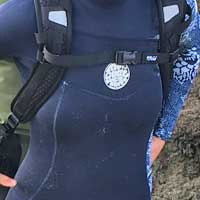
Waist and chest straps
Most dry bag backpacks are fitted with a simple waist strap that keeps the bag from bouncing when walking. Larger packs should have a more comfortable waist strap as well as a chest strap.
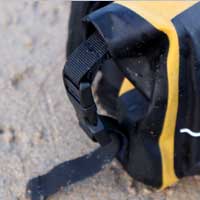
Compression straps
These are usually found on the sides of the dry bag. They clinch down the roll-top but, to minimise gear movement, some have additional horizontal compression straps.

High-visibility strips
Another useful feature if you like to get out before sunrise or after sunset. The more high-visibility strips the backpack has, the more visible you’ll be to passing cars or other adventurers.

Haul handle
A really useful feature for moving your bags from place to place. They’re also handy for pulling bags out of storage holes or out of other bags.

Shoulder sling
Medium sized dry bags without backpack straps are much more usable with a carry strap to sling over your shoulder. These are especially useful when carrying your vessel to and from the water as they free up your hands.


